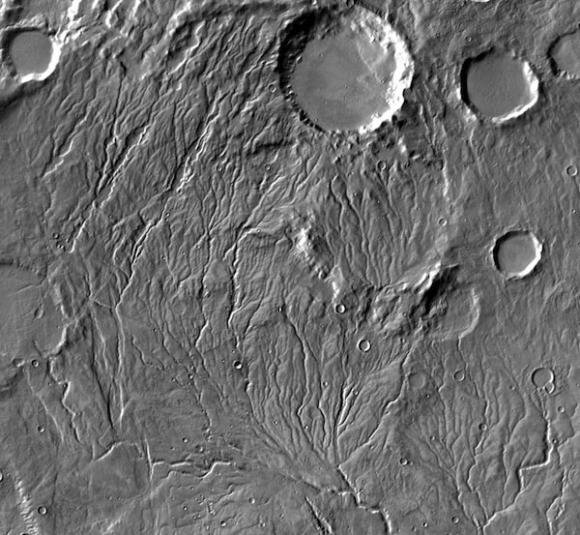Meltwater From Glaciers May Have Flowed on Ancient Mars

The wet past of Mars may have unfolded in short bursts. Even though climate models suggest that the Red Planet's temperatures mostly remained below freezing, new research from scientists at Brown University suggests that daily temperatures in the summer would have been just warm enough to melt the edges of glaciers, producing small amounts of meltwater that could explain the planet's river-like valleys.
"We see this in the Antarctic dry valleys, where seasonal temperature variation is sufficient to form and sustain lakes even though mean annual temperature is well below freezing. We wanted to see if something similar might be possible for ancient Mars," said lead author Ashley Palumbo, a Brown Ph.D. student, in a statement.
Palumbo's supervisor and co-author, Jim Head, is a Brown professor who has worked on the European Mars Express and NASA Mars Surveyor missions, among many others. Their new study is published in the journal Icarus.
Mars today has an atmosphere of mostly carbon dioxide, with little to no water flowing on its surface. (Some researchers argue that recurring slope lineae on crater walls are a form of melting, briny water, while others say the features may be hydrated salts or formed from water in the atmosphere.) The Brown researchers began their work by using a state-of-the-art climate model of Mars that also assumed a carbon dioxide atmosphere. Simulations generally trend toward an icy planet; one of the factors was the sun, whose energy output was lower than today.
RELATED: Massive Ice Reservoir on Mars Could Keep Settlers Alive
Palumbo's team re-ran the model for variables that were relevant four billion years ago, when the valleys, lakebeds, and other prominent water-carved features were formed on Mars. They included scenarios with different atmospheric thicknesses and different amounts of greenhouse gases, since scientists aren't in agreement about what the atmosphere looked like in the early years of the Red Planet.

They also ran different orbital scenarios, since there isn't agreement on what the Martian orbit was back then. This includes different axial tilts, which affect the amount of sunlight on the planet's surface, and eccentricity, which deals with the degree to which a planet's orbit differs from a perfect circle. A planet with a more eccentric orbit can have more extreme seasons, since it is moving farther from and closer to the sun as it travels along the orbit.
Get the Space.com Newsletter
Breaking space news, the latest updates on rocket launches, skywatching events and more!
RELATED: Well-Preserved Hydrothermal Deposits on Mars Offer a Window Into Early Earth
To relate the water runoff to the formation of valley networks, the researchers referred to a 2015 study that Head co-authored with Eliot Rosenberg, an undergraduate at Brown who has since graduated. The study estimated how much water was needed at a minimum to create the valleys. Using that study, along with other researchers' work on runoff rates and the valley network's history, Palumbo concluded that Mars would have needed an eccentric orbit to produce enough water for valley network creation.
"This work adds a plausible hypothesis to explain the way in which liquid water could have formed on early Mars, in a manner similar to the seasonal melting that produces the streams and lakes we observe during our field work in the Antarctic McMurdo Dry Valleys," Head said in a statement. "We are currently exploring additional candidate warming mechanisms, including volcanism and impact cratering, that might also contribute to melting of a cold and icy early Mars."
RELATED: Methane Bursts May Have Helped Water Flow on Ancient Mars
The work appears in the same month that a University of Chicago-led team, which was also trying to figure out how Mars was wet in its ancient past, came up with another explanation: methane. Those researchers suggested that the tilt of the Red Planet's axis wobbled over time, triggering periods of ice melt and methane release. Over time, enough methane built up in the atmosphere to allow for lake-forming climates.
Separately, NASA's Mars Atmosphere and Volatile Evolution (MAVEN) spacecraft is examining another line of evidence for Mars' wetter days. Some scientists suggest that the atmosphere was thick enough in the ancient past to allow water to flow. Today, water can't exist at the surface due to the very thin atmosphere. MAVEN is looking at the rate of atmospheric loss over time, which occurs due to processes such as "stripping" — when particles from the sun slam into lighter molecules in the Martian atmosphere, pushing the atmospheric molecules into space.
Originally published on Seeker.
Join our Space Forums to keep talking space on the latest missions, night sky and more! And if you have a news tip, correction or comment, let us know at: community@space.com.

Elizabeth Howell (she/her), Ph.D., was a staff writer in the spaceflight channel between 2022 and 2024 specializing in Canadian space news. She was contributing writer for Space.com for 10 years from 2012 to 2024. Elizabeth's reporting includes multiple exclusives with the White House, leading world coverage about a lost-and-found space tomato on the International Space Station, witnessing five human spaceflight launches on two continents, flying parabolic, working inside a spacesuit, and participating in a simulated Mars mission. Her latest book, "Why Am I Taller?" (ECW Press, 2022) is co-written with astronaut Dave Williams.









